- Home
- Blog
Blog
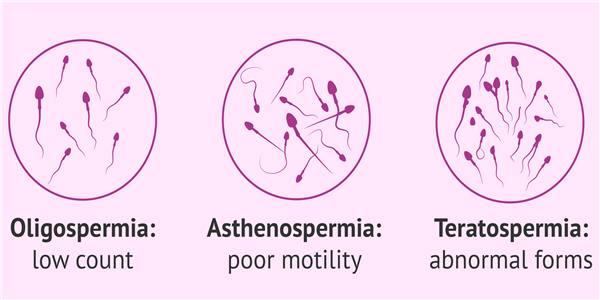
MALE INFERTILITY TERATOSPERMIA
On 26/12/2019
The teratospermia (or teratospermia ) is a sperm abnormality characterized by sperm having morphologies defects. Due to these deformities, the fertilizing power of sperm is impaired, and the couple may have difficulty conceiving. However, the experts at Dawasanté provide you with a natural treatment to permanently cure teratospermia and allow you to conceive quickly.
Click here or on the image below to find out what treatment
We deliver all over the world.
For more information, you can contact our experts at +229 51374202 direct line or by WhatsApp at the same number.
Teratospermia is a sperm abnormality characterized by sperm with morphologic defects. These abnormalities can affect different parts of the sperm:
- the head, which contains the nucleus carrying the 23 paternal chromosomes;
- the acrosome, a small membrane at the front of the head that, at the time of fertilization, will release enzymes that will allow the sperm to cross the pellucid area of the oocyte;
- the flagellum, this "tail" which allows it to be mobile and therefore to move up from the vagina to the uterus and then the tubes, for a possible encounter with the oocyte;
- the intermediate part between the flagellum and the head.
Often, the anomalies are polymorphic: they can be multiple, in size or shape, affect both the head and the flagellum, vary from one sperm to another. It may be globozoospermia (absence of acrosome), double flagellum or double head, coiled flagellum, etc.
All these abnormalities have an impact on the fertilizing power of the sperm, and therefore on the fertility of the man. The impact will be more or less important depending on the percentage of normal sperm remaining. Teratospermia can decrease the chances of conception and even lead to male infertility if it is severe.
Often, teratospermia is associated with other spermatic abnormalities: oligospermia (insufficient number of spermatozoa-, asthenospermia (defect in sperm mobility. We then speak of oligo-asthenic-teratozoospermia (OATS).
Like all sperm abnormalities, the causes can be hormonal, infectious, toxic, drug-related. The morphology of spermatozoa is in fact the first parameter to be altered by an external factor (exposure to toxicants, infection, etc.). More and more specialists also consider that atmospheric and food pollution (via pesticides in particular) has a direct impact on the morphology of spermatozoa.
But sometimes, no cause is found.
The main symptom of teratospermia is difficulty conceiving. The fact that the shape of the sperm is abnormal does not affect the occurrence of malformations in the unborn child, but only the chances of pregnancy.
Teratospermia is diagnosed using a spermogram, one of the first examinations systematically performed in men during an infertility assessment. It allows a qualitative and quantitative study of sperm thanks to the analysis of different biological parameters:
- the volume of the ejaculate;
- pH;
- sperm concentration;
- the mobility of sperm;
- sperm morphology;
- the vitality of sperm.
The part about sperm morphology is the longest and most difficult part of the spermogram. In a test called a spermocytogram, 200 sperm are fixed and stained on smear slides. Then the biologist will study the different parts of the sperm under a microscope in order to assess the percentage of morphologically normal sperm.
The type of morphological abnormalities is also taken into account to estimate the impact of teratospermia on fertility. Several classifications exist:
- the David classification modified by Auger and Eustache, still used by certain French laboratories;
- the Kruger classification, the WHO international classification, is the most widely used in the world. Carried out using an automatic machine, this more “severe” classification classifies as atypical spermatozoa any spermatozoon which deviates, even very little, from the form considered as normal.
If the proportion of correctly formed sperm is less than 4% according to the WHO classification, or 15% according to the modified David classification, teratospermia is suspected. But as for any spermatic abnormality, a second or even a third spermogram will be carried out 3 months apart (the duration of a spermatogenesis cycle being 74 days) in order to make a firm diagnosis, especially as various factors can influence on sperm morphology (long abstinence time, regular cannabis intake, feverish episode, etc.).
A migration-survival test (TMS) usually completes the diagnosis. It makes it possible to have an evaluation of the number of spermatozoa able to end up in the uterus and able to fertilize the oocyte.
A sperm culture is often coupled with the spermogram in order to detect an infection which could alter spermatogenesis and lead to morphological defects of the sperm.
Teratospermia occurs when less than 4% of the sperm present in the male ejaculate is said to be “typical” or normal. The remaining 96% are carriers of abnormalities or have an alteration in their morphology. A normal sperm consists of an oval head, an intermediate body one and a half times longer than the head, and a long, thin tail (the flagellum) which promotes its mobility. The abnormalities detected can affect the head of the spermatozoon as well as its intermediate part or even its flagellum. There are also combined forms of anomalies.
Teratospermia is usually the cause of male infertility. Indeed, alterations in the morphology of spermatozoa can affect their mobility and prevent them from reaching the egg. There are different degrees of severity of teratospermia which can be classified as mild, moderate, or severe. The higher the degree of severity, the more difficult natural procreation will be.
Little is known about the causes of this anomaly. The origin can be infectious, medicinal, genetic, anatomical (varicocele or varicose veins of the testes), environmental or related to the hygiene of life. Finally, there are reversible forms of teratospermia. This is why the patient is generally asked to perform a second examination, 3 months apart from the first, in order to detect the persistence of the anomaly.
We deliver all over the world.
For more information, you can contact our experts at +229 51374202 direct line or by WhatsApp at the same number.

UNDERSTANDING THE SPERMOGRAM: Natural treatment
On 26/12/2019
UNDERSTANDING THE SPERMOGRAM
The semen is the result of the laboratory examination of the semen. Regardless of the poor quality and quantity of your sperm, Dawasanté experts provide you with a natural herbal treatment to improve the quality and quantity of your sperm. This will allow you to conceive quickly and be more fertile. Click on the image below to discover this natural treatment
We deliver all over the world.
For more information, you can contact our experts on +229 51374202 direct line or by WhatsApp at the same number.
Topic: AKINETOSPERMIA, ASPERMIA, ASTHENOSPERMIA, AZOOSPERMIA, Cryptozoospermia, DYSKINESIA, FLAGELLAR, HYPERSPERMIA, HYPOSPERMIA, AGGREGATES, LEUCOSPERMIA, NECROSPERMIA, Oligo-Asthenoospermia, TOSPEROPERMIA, POLYPERSPATERMIA, TERATOSPERSPATERMIA, TOSPEROPERMIA
I - WHAT IS A SPERMOGRAM?
The spermogram is an analysis that will study the quantity and quality of sperm.
The spermogram is carried out after having collected the sperm in the laboratory and by masturbation.
The spermogram includes:
1 - An analysis of the volume of the ejaculate
2 - A determination of the pH
3 - The study of the mobility of the spermatozoa at the emission of the sperm and after 1 hour and 3 hours
4 - The calculation of the number of spermatozoa
5 - Their vitality
6 - Viscosity
7 - The percentage of abnormal forms observed under the microscope…
In addition, we also evaluate:
8 - The level of isolated flagella and / or lysed spermatozoa
9 - The level of white line cells
10 - The level of other cells (cells of the urogenital tract)
11 - The level of cell fragments
12 - The presence of red blood cells or blood residue
II - REFERENCE VALUES
1 - Quantity
2 to 6 ml
2 - Color
Normally viscous and opalescent white
3 - viscosity
On ejaculation, the sperm coagulates and liquefies in less than 30 minutes at 37 ° C
4 - Number
- From 40 million to 200 million per ml.
- Greater than 15 million per ml and must be greater than 39 million
for the entire ejaculate
5 - Mobility
This is the most important parameter
The mobility standard accepted after 30 minutes of the emission must not be below 80% of motile spermatozoa
- After 1 hour -
We must find more than 50% of motile spermatozoa
that is to say in progressive displacement
- After 3 hours -
We must find at least 30% of motile spermatozoa
Observation
The mobility of sperm is classified into four categories or grades (see below).
6 - Vitality
At ejaculation, the percentage of living spermatozoa must be
equal to or greater than 60% of all spermatozoa
7 - Leukocytes
The number of leukocytes must be less than 1 million / ml
8 - Abnormal forms
- According to the classification of Cohen Bacri
Abnormal forms should not exceed 15 to 20% of the total sperm
- According to the classification of “David”
Abnormal forms must not exceed 30%, of the total sperm
- According to the classification of “Kruger”
Abnormal forms must not exceed 4%, of the total spermatozoa
9 - The pH
It must be between 7.2 to 8
Good to know
The pH is a direct indicator of secretions from the annex glands (acid prostatic secretions and secretions from the seminal vesicles).
10 - Germ cells
Their percentage must not exceed 10%
Germ cells are the basic cells that evolve into the sperm after a complex transformation; a higher level may suggest a disorder in sperm production.
III - INTERPRETATION OF THE RESULTS
Male infertility can be caused:
1 - By poor quality sperm production
2 - By insufficient sperm production
3 - By an anomaly in the transport of these spermatozoa
Spermatozoon and its various abnormalities
IV - THE MAIN ANOMALIES
1 - HYPOSPERMIA
The total volume of the ejaculate less than 2 ml
The causes of hypospermia are varied:
- Technical problem in collecting sperm
- Abstinence
- Secretion deficit
- Retrograde ejaculation…
Good to know
The volume of semen gradually decreases with age without altering the other parameters.
2 - HYPERSPERMIA
The volume of the ejaculate much greater than normal
Hyperspermia and sometimes in connection with an inflammatory or infectious syndrome of the annex glands and more particularly the seminal vesicles.
Important
It can also be due to excessive sexual abstinence.
3 - OLIGOSPERMIA (OLIGOZOOSPERMIA)
It corresponds to an insufficient quantity of spermatozoa in the semen
Very important to know
1 - If the number of spermatozoa is less than 10 million / ml, there is infertility
2 - If the number of sperm is less than 5 million per ml, we speak of severe oligospermia.
4 - POLYSPERMIA
The concentration of spermatozoa greater than 200 million per ml
5 - AZOOSPERMIA
Absence of spermatozoa in the ejaculate
Two types of azoospermia are encountered:
1 - Secretory azoospermia -
Corresponds either to a primary, congenital or acquired testicular disease, or to an acquired congenital hypothalamic-pituitary insufficiency.
2 - Excretory azoospermia -
Corresponds to the presence of an obstacle in the excretory tract (epididymis, vas deferens, ejaculatory ducts).
These lesions can be acquired or congenital.
6 - ASTHENOSPERMIA Sperm
mobility defect
We speak of asthenospermia if at least 40% of the spermatozoa encountered are not mobile.
Sperm mobility is classified into four categories or classes -
1 - Class A -
Fast and progressive spermatozoa (speed> 25 µm / s)
2 - Class B -
Slow or weakly progressive spermatozoa (speed 5 - 25 µm / s)
3 - Class C -
Mobile spermatozoa but without any progressivity (mobility in place)
4 - Class D -
Immobile spermatozoa
 7 - NECROSPERMIA (NECROZOOSPERMIA)
7 - NECROSPERMIA (NECROZOOSPERMIA)
It is characterized by a very high percentage of dead spermatozoa
Necrospermia is often due to microbial infections.
There are two types of necrospermia:
1 - Partial necrospermia -
Corresponds to 42% of the spermatozoa found are dead
2 - Total necrospermia -
Corresponds to all the sperm found in the ejaculate are dead
8 - TERATOSPERMY OR TERATOZOOSPERMIA
It corresponds to an excessive quantity of abnormal spermatozoa
and can reach up to 30%
(see above, abnormal forms).
The main abnormal forms encountered are -
1 - Head abnormalities (less than 35%) -
Microcephaly, macrocephalic, elongated head, irregular head ...
2 - Anomalies of the intermediate part (less than 20%) -
The result from the presence of cytoplasmic remains
3 -Flagellum abnormalities (less than 20%) - Angulated, coiled flagellum ...
4 - Double forms (less than 10%) -
5 - The globozocephalic form -
Characterized by the absence of the acrosome.
The presence of this form is a sign that there is no possibility of fertilization.
9 - ASPERMIA
A total absence of ejaculate
10 - OAT
(Oligo-Astheno-Teratozoospermia)
It is the association of three pathologies and which are: Oligospermia, Astheno-spermia and Teratozoospermia.
11 - AGGLUTINATES
Agglutinates (or adjoining) correspond to a gathering of several spermatozoa living together.
The agglutinates are explained by the presence of living sperm and carriers of anti-sperm antibodies.
The presence of agglutinated spermatozoa should cause the presence of anti-sperm antibodies to be tested.
12 - AGGREGATES
They are to be distinguished from agglutinates because they correspond to the joining of several spermatozoa which have died together.
13 - FLAGELLAR DYSKINESIA
Abnormalities in the movements, speed and trajectory of spermatozoa
14 - LEUCOSPERMIA
Leukocytosis at more than 1 million / ml
This leukospermia suggests an infection
15 - AKINETOSPERMIA
All spermatozoa are immobile
16 - CRYPTOZOOSPERMY *
Absence of spermatozoa observed in a drop of sperm under the microscope
A thorough search in the whole of the sperm allows one to find some spermatozoa (less than 100,000 spermatozoa in the whole of the ejaculate).
There are two main cryptozoospermia -
1 - Severe cryptozoospermia
The number of spermatozoa found is less than 10,000
2 - Moderate cryptozoospermia,
The number of spermatozoa is greater than 10,000
* Important -
Cryptozoospermia is a new entity which has only gained interest since the appearance of the ICSI technique (Intra Cytoplasmic Sperm Injection) because with this technique, just a few spermatozoa ejaculated or taken from epididymis or testis, and regardless of sperm concentration and mobility, to achieve fertilization and pregnancy.
The appearance of the new technique of IMSI (Intra Cytoplasmic Morphologic Sperm Injection) which makes it possible to make a very thorough selection of the best spermatozoa in the ejaculate and to significantly increase the chances of obtaining fertilization and pregnancy from cryptozoospermic sperm.
17 - HEMOSPERMIA
It is the presence of blood in the sperm
V - APPENDIX
Seminal biochemistry -
It makes it possible to pose different types of pathology either having an origin of an obstacle being on the seminal tract, or of origin by malformation of the ways of excretion of the spermatozoa and more particularly at the level of the epididymis, duct vas deferens, seminal vesicles, prostate.
The main substances of dosed are carnitine, alpha-glucosidase, citrate, acid phosphatases, zinc, fructose, etc.
We deliver all over the world.
For more information, you can contact our experts on +229 51374202 direct line or by WhatsApp at the same number.
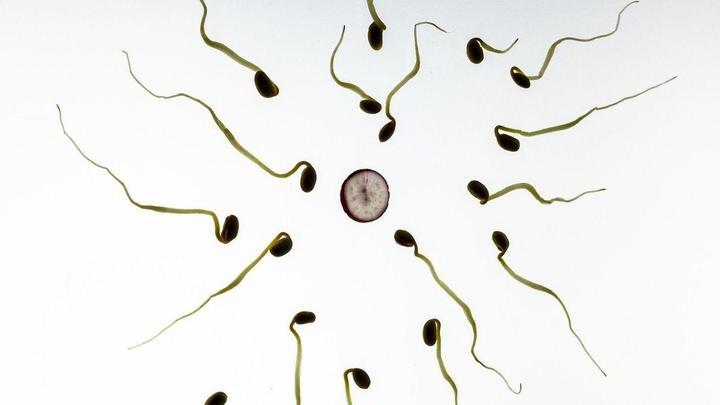
TERATOSPERMIA AND PREGNANCY: Natural treatment
On 26/12/2019
The teratospermia (or teratozoospermia ) is a sperm abnormality characterized by sperm having morphologies defects. Due to these deformities, the fertilizing power of sperm is impaired, and the couple may have difficulty conceiving. However, Dawasanté experts provide you with a natural plant-based treatment to treat your teratospermia and allow you to conceive quickly.
Click HERE or on the image below to discover this natural treatment.

We deliver all over the world.
For more information, you can contact our experts on +229 51374202 direct line or by WhatsApp at the same number.
Obtaining a natural pregnancy with teratozoospermia can be complicated, and in the most severe cases it is virtually impossible for fertilization to take place and the embryo to develop afterward.
Men who are infertile with teratozoospermia will need to use assisted reproduction techniques to become parents.
The appropriate treatment for PMA will depend on many factors, not just the degree of sperm abnormalities. The rest of the seminal parameters, as well as the age and state of health of the woman, are also limiting when it comes to achieving pregnancy.
Below you will find an index with all the points that we will cover in this article.
1-Natural pregnancy
Amorphous sperm can make pregnancy difficult for any of the following reasons:
- They have more difficulty moving due to their abnormal shape, which prevents them from reaching the egg in the fallopian tube .
- Abnormalities in the head can prevent sperm from entering the egg so it can be fertilized.
- When the cause of teratozoospermia is genetic, the resulting embryo may have DNA alterations that prevent its correct development.
Infertility due to teratospermia
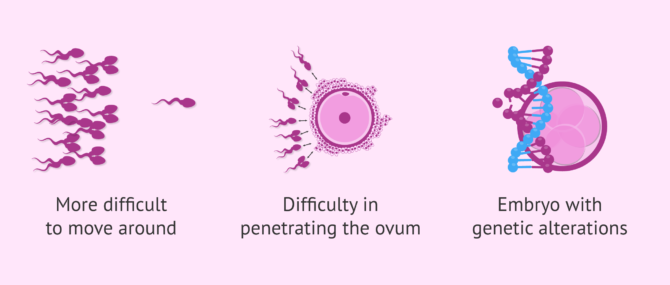
All these reasons make natural pregnancy not possible or its arrival is delayed.
When the degree of teratozoospermia is low, the normal sperm that exists in the semen could lead to a viable pregnancy. Depending on the parameters of sperm concentration and mobility, the probability of natural pregnancy with teratozoospermia will be higher or lower.
On the other hand, when teratozoospermia is moderate, severe or associated with another disorder ( oligozoospermia or asthenozoospermia ), the couple will most likely need ART treatment to have a child.
2-Medically assisted procreation treatments
Once the diagnosis of teratospermia has been obtained, depending on its severity and other values of the spermogram, the specialist will recommend the treatment that offers the best guarantees of success in the couple.
It should be noted that the reproductive status of women also plays an important role in this decision. When the male factor is the problem, there are several assisted reproduction techniques that can be performed depending on the characteristics of each patient.
2-1 Artificial insemination (AI)
The artificial insemination is the introduction of sperm directly into the uterus of a woman to get pregnant. Beforehand, it will be necessary to perform the capacitation of the sperm sample and to perform ovarian stimulation in the woman.
This assisted reproduction treatment can give good results in cases of mild teratozoospermia (3-4% of sperm are normal), provided that the number and mobility of sperm are affected.
To perform artificial insemination, a man must obtain a total of 2-3 million progressively motile sperm in the REM spermogram.
In addition, the woman must be under 35 - 36 years old, have leaky fallopian tubes and have no other serious infertility problem. If you want more information about this treatment, we recommend that you consult the following article: What is artificial insemination?
2-2 In vitro fertilization (IVF)
IVF is one of the most important treatments for assisted human reproduction. It consists of taking several mature eggs from the woman after ovarian stimulation and follicular puncture, then putting them in direct contact with male sperm and carrying out fertilization.
This method offers good results in cases of moderate teratozoospermia (1-2% of normal sperm) or mild teratozoospermia when the woman is over 35 years old. It would also be the treatment to try if, after several artificial inseminations, no pregnancy is obtained.
There is a variant of IVF in which fertilization is forced by the direct introduction of the sperm into the egg. This is called an intracytoplasmic sperm injection ( ICSI ).
ICSI is mainly used in cases of severe teratozoospermia (total normal sperm is less than 1%) or if the above techniques have not worked.
However, most IVF treatments today use ICSI as a technique for creating the embryos, as it offers a higher success rate than conventional IVF.
We recommend that you read the following article for more detailed information on this technique: What is ICSI and how much does it cost?
PMA, like any medical treatment, requires that you trust the professionalism of the doctors and clinic you have chosen. Obviously, not all are the same. The Fertility Report selects the most advantageous clinics for you based on our rigorous quality criteria. In addition, the system performs a comparison of prices and conditions offered by different clinics to facilitate your decision making.
2-3 IMSI
The IMSI is a variant of the ICSI technique that was discussed in the previous section. It is based on a more rigorous selection of the spermatozoa to be micro-injected according to their morphology.
To do this, we use an electron microscope with a superlens that offers a magnification of over 6,000 times.
This technique offers many advantages in the case of teratozoospermia because it allows us to visualize in detail the morphology of the spermatozoa and to choose the best ones.
Another benefit of IMSI is that it reduces the likelihood of miscarriage with its use.
The IMSI technique

If you want to know more about it, you can read the following article: What is IMSI?
3-Your frequently asked questions
3-1 Which assisted reproduction treatment is most appropriate for a pregnancy when the man has teratozoospermia?
By Zaira Salvador (embryologist).
The fertility treatment indicated for a couple with teratospermia will depend on various factors, such as the degree of teratozoospermia, the age of the woman, the time of infertility, etc.
The most appropriate, in general, would be to undergo in vitro fertilization (IVF) treatment with intracytoplasmic sperm injection (ICSI).
Read more
3-2 Can abnormal sperm cause miscarriages?
By Zaira Salvador (embryologist).
Having teratozoospermia does not imply that there is a greater risk of miscarriage when the pregnancy has already been achieved. However, if the cause of teratozoospermia is genetic and the sperm carry DNA mutations, a miscarriage or the birth of a sick child could occur.
3-3 Can teratozoospermia lead to pregnancy with Down syndrome?
By Zaira Salvador (embryologist).
Teratozoospermia is not directly related to trisomy 21, which is the chromosomal alteration that causes Down syndrome. However, sperm with abnormal morphology may have genetic abnormalities that cause fertilization failures, a greater likelihood of miscarriages, or other pathologies.
3-4 What is the appropriate treatment for a couple with teratozoospermia and PCOS?
By Zaira Salvador (embryologist).
Treatment will depend on the degree of teratozoospermia and the age of the woman. If the teratozoospermia is mild and the woman is under 35, it is possible to try artificial insemination. If the above requirements do not work or are not met, in vitro fertilization would be necessary.
It is estimated that 30 to 40% of fertility disorders are due to abnormalities in the fertility of the male partner. In men, infertility is related to the quality and number of sperm in semen.
Male fertility abnormalities
There are four types of sperm abnormalities, which can be associated in the same person.
What is azoospermia?
We speak of azoospermia when the semen does not contain sperm. This fertility disorder may be due to:
- absence or abnormality in the production of sperm (for example, in a man who has undergone cancer treatment with radiotherapy to the pelvis or chemotherapy, and whose cells that make sperm have been damaged by this treatment) ;
- blockage of the pathways used by sperm from the testes to the organs where sperm is stored (the seminal vesicles). Sometimes the transport channels are blocked and the sperm cannot travel to the seminal vesicles. These obstacles may be congenital or due to an ill-treated sexually transmitted infection.
What is oligospermia
We speak of oligospermia when the sperm contains too low a number of sperm. The causes of oligospermia are similar to those of azoospermia.
What is teratospermia?
The teratospermia is the presence of sperm "abnormal" in large numbers in semen. It is due to a manufacturing defect in the testicles. Malformed sperm have difficulty moving or fail to enter the oocyte.
What are the risk factors for male fertility disorders?
Some risk factors for infertility have been identified in humans:
- age (over 40);
- smoking or alcoholism ;
- factors that expose the testes to too high a temperature (too frequent hot tubs and baths, saunas and steam rooms, too much time spent driving, etc.): the production of sperm requires a temperature of the testes lower than that of the body (i.e. is for this reason that they are outside). Sometimes, the venous circulation is bad at the level of the testicles (it is the “varicocele”) and their temperature increases with a higher risk of infertility.
- toxic products used in certain professions;
- a medical history (especially cancer treatment or mumps).
We deliver all over the world.
For more information, you can contact our experts on +229 51374202 direct line or by WhatsApp at the same number.

TERATOSPERMIA TREATMENT: Can it be cured?
On 26/12/2019
The teratospermia (or teratozoospermia ) is a sperm abnormality characterized by sperm having morphologies defects. Due to these deformities, the fertilizing power of sperm is impaired, and the couple may have difficulty conceiving. However, Dawasanté experts provide you with a natural plant-based treatment to improve the quality and quantity of your sperm.
Click HERE or on the image below to discover this treatment.
We deliver all over the world.
For more information, you can contact our experts on +229 51374202 direct line or by WhatsApp at the same number.
Teratozoospermia can occur from birth, which is thought to be due to a genetic cause or be acquired over time through hormonal changes or trauma. Depending on the cause, it will be possible to apply personalized treatment to reverse this situation.
In congenital cases of teratozoospermia, it is very difficult to obtain a cure. The same is true when these changes are the result of cancer treatment. In severe cases of teratozoospermia, assisted reproduction will be necessary to become parents.
However, when the degree of teratospermia is lower, there are pharmacological or natural treatments that can help restore sperm quality.
Natural treatment
Since the exact cause of teratozoospermia is not known, it is difficult to apply a solution to problems with sperm morphology.
However, a healthy lifestyle can greatly influence the quality of sperm. For this reason, there may be variations in sperm values within a few months of each other.
Proper treatment should ensure that the process of sperm maturation during spermatogenesis proceeds properly. Therefore, we are going to discuss some recommendations for maintaining good habits that promote this correct formation of sperm.
1-1 Power supply
A healthy and balanced diet improves general health. In addition, the vitamins and antioxidants contained in certain foods also provide benefits to the quality of sperm.
These are some of the important components that a man should include in his diet to improve his fertility status:
- Selenium
- Vitamin C
- Zinc
- Omega-3 fatty acids
- this mineral is found in Brazil nuts, walnuts, tuna, beef, chicken, eggs and cheese. It should be taken in small amounts, otherwise it can be toxic.
- in spinach, tangerines, strawberries and tomatoes. Vitamin C is a powerful antioxidant and also helps in the absorption of iron.
- it is a mineral found in foods such as oysters, clams or red meat. Zinc is essential for the functioning of enzymes, which are responsible for producing energy in the body.
- in fatty fish and crustaceans. It is very important to include them in the diet because the human body is not able to synthesize them on its own. In addition, it brings multiple benefits to the cardiovascular system, the nervous system, the immune system, etc.
- Healthy and balanced diet to cure teratozoospermia

1-2 olive oil
Olive oil is essential in the Mediterranean diet and also has reproductive properties thanks to its oleic acid content.
Oleic acid acts as a lowering agent for bad cholesterol or LDL levels which can build up in the testes, making it difficult to produce sperm properly.
Olive oil also helps raise good cholesterol or HDL levels and prevent the risk of heart and brain complications.
In short, olive oil is an ally in the fight against male infertility and especially teratozoospermia.
PMA, like any medical treatment, requires that you trust the professionalism of the doctors and clinic you have chosen. Obviously, not all are the same. The Fertility Report selects the most advantageous clinics for you based on our rigorous quality criteria. In addition, the system performs a comparison of prices and conditions offered by different clinics to facilitate your decision making.
1-3 Avoid heat
High temperatures in the testes affect sperm production and can cause sperm abnormalities.
Therefore, men with infertility issues should consider the following recommendations:
- Do not use the laptop on your legs.
- Avoid saunas in general.
- Wear boxers and wide pants.
- Try not to cycle long distances.
Once the temperature decreases and the heat exposure decreases, the testes return to their normal function and the quality of sperm improves in a short time.
1-4 Eliminate toxins
Some compounds that we are exposed to on a daily basis can be very harmful to reproductive health without our being aware of it.
Tobacco, drugs, marijuana smoke, pesticides, chemicals, and excessive amounts of alcohol can cause sperm deformity.
It is therefore important to eliminate these bad habits from your environment.
2-Vitamin supplements
In some cases of teratozoospermia, it is common for the urologist to advise the administration of certain nutritional supplements that supplement the diet in order to obtain a better result.
The most common treatment is a vitamin and antioxidant supplementation.
Antioxidants are responsible for reducing the oxidative stress to which sperm are exposed, which causes cell damage and the fragmentation of their DNA.
Some recommended dietary supplements include vitamin E or essential amino acids like L-carnitine. Vitamin E treatment is also recommended for chemotherapy and radiation therapy, as it is a very powerful antioxidant.
On the other hand, Andean maca supplements are also very beneficial due to the multitude of properties of this Peruvian plant.
It should be noted that these compounds are not miraculous and that in no case will it be possible to regain total fertility if the seminal parameters are severely affected.
However, when there is mild teratozoospermia, they can help and give a little boost for men with vitamin deficiencies in the diet.
Peruvian Maca powder to treat teratozoospermia

3-Your frequently asked questions
3-1 Is there a cure for severe teratozoospermia?
If a man has less than 5% of sperm with normal morphology, it is very difficult to find a normal value with natural or pharmacological treatment. Improvement can be seen over time, especially if the man maintains a healthy lifestyle.
On the other hand, if the teratozoospermia appears associated with another pathology such as, for example, varicocele, it is possible that the spermogram improves its parameters during a surgical intervention to eliminate the varicocele.
3-2 Can acupuncture be of benefit in the treatment of teratozoospermia?
There are studies that say yes. In general, acupuncture has been successful in increasing pregnancy rates in idiopathic infertility, that is, when the origin is unknown. An improvement in seminal quality has also been observed in men with oligospermia, asthenospermia and teratospermia who practice acupuncture.
3-3 Does eating forest fruits improve seminal quality?
Yes, many forest fruits have antioxidant pigments and a great capacity for absorbing oxygen free radicals, so this food group is perfect if you want to improve or protect sperm quality.
Some research has uncovered the medicinal properties of pigmented polyphenols, such as flavonoids, anthocyanins, tannins and other phytochemicals present in the skin and seeds of these fruits.
Moreover, blueberries, blackberries, currants and strawberries are rich in vitamin C and other nutrients. Vitamin C is a powerful antioxidant that protects cells from cellular damage.
We deliver all over the world.
For more information, you can contact our experts on +229 51374202 direct line or by WhatsApp at the same number.

TYPES OF TERATOSPERMIA: mild, moderate, and severe
On 26/12/2019
The teratospermia (or teratozoospermia ) is a sperm abnormality characterized by sperm having morphologies defects. Due to these deformities, the fertilizing power of sperm is impaired, and the couple may have difficulty conceiving. This is how the Dawasanté experts provide you with a natural treatment to treat all your fertility problems related to the quality and quantity of your sperm.
Click HERE or on the image below to discover this natural treatment
We deliver all over the world.
For more information, you can contact our experts on +229 51374202 direct line or by WhatsApp at the same number.
Teratozoospermia or teratospermia is a seminal alteration that involves a high percentage of abnormally shaped sperm.
It is a cause of male infertility, the severity of which will depend on the greater or lesser number of amorphous sperm cells in the semen.
According to the different criteria used to assess the degree of teratozoospermia, we can distinguish 3 types: mild, moderate, or severe.
1-Classification of teratozoospermia
When a man performs a spermogram to assess the quality of his sperm, in the results report, he will obtain the values of all seminal parameters, including sperm morphology.
A man is considered to have teratozoospermia when the percentage of sperm with normal morphology in his seminogram is less than 4%, according to criteria established by the World Health Organization (WHO) in 2010.
On the other hand, some labs also use Kruger's strict criteria to diagnose teratozoospermia. According to Kruger, a man suffers from teratozoospermia when less than 15% of his sperm has a normal form.
Percentage of normal sperm
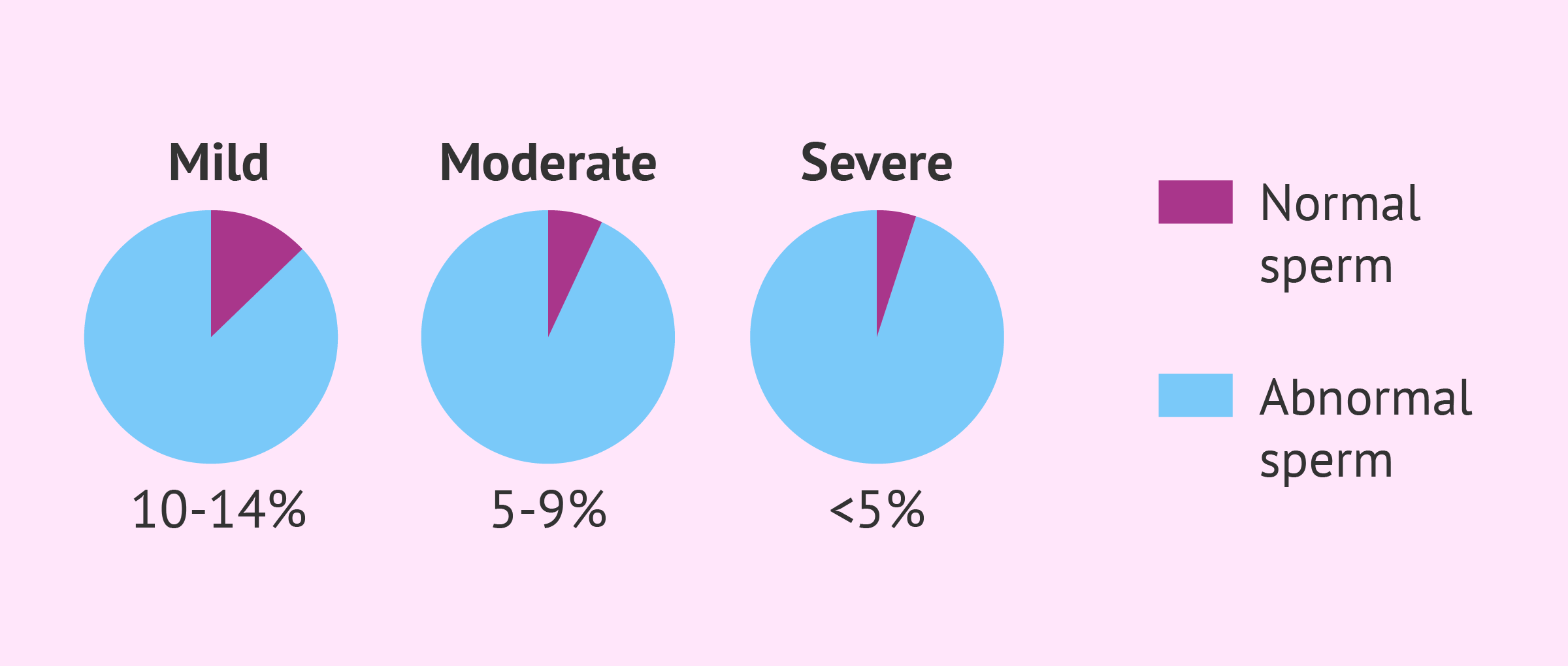
Since the WHO benchmark is so low, there is no point in talking about types of teratozoospermia based on the number of normal sperm. Therefore, for the classification of spermatozoa in this sense, it is better to use Kruger's criterion, which is stricter than the previous one.
1-1 Mild teratozoospermia
A man suffers from mild teratozoospermia when the number of normal sperm in his spermogram ranges from 14% to 10%.
The rest of the sperm will have an abnormality in their head, neck or tail. Despite this, men with mild teratospermia do not have a bad prognosis for having children.
If assisted reproduction techniques are necessary to achieve pregnancy, artificial insemination (AI) and in vitro fertilization ( IVF ) may be performed, depending on the concentration and mobility of the sperm.
The shape of the sperm is important for the fertilization of the egg. However, men with mild teratozoospermia can achieve a natural pregnancy.
In addition, there are various dietary supplements that contain vitamins and antioxidants that help in the maturation of sperm and can improve their morphology.
If you are interested in this topic, you can read the following article: Treatment of teratozoospermia.
1-2 Moderate teratozoospermia
Moderate or severe teratozoospermia is diagnosed when sperm results show that only 9-5% of sperm have a normal shape.
With this diagnosis, it is quite complicated to have children naturally. To achieve a pregnancy with moderate teratozoospermia, an in vitro fertilization technique such as ICSI will most likely be necessary.
The ICSI (Intracytoplasmic Sperm Injection) is based on the selection of spermatozoa under a microscope and their direct injection into each egg and fertilization.
PMA, like any medical treatment, requires that you trust the professionalism of the doctors and clinic you have chosen. Obviously, not all are the same. The Fertility Report selects the most advantageous clinics for you based on our rigorous quality criteria. In addition, the system performs a comparison of prices and conditions offered by different clinics to facilitate your decision making.
1-3 Severe teratozoospermia
When the spermogram morphology test shows a normal sperm value of less than 5%, the man has severe or severe teratozoospermia.
Sperm with good morphology is therefore very few in number and, therefore, the possibility of achieving natural pregnancy is very low.
Spermatozoa with alterations in their morphology have problems progressing gradually, they have more difficulty reaching the egg, penetrating its thick pellucid layer and also fusing its male nucleus with the female one. The consequence of all this is that they can lead to fertilization failures.
Teratozoospermia and fertilization failure

The most suitable assisted reproduction technique for extreme teratozoospermia is ICSI or its improved variant: IMSI.
The IMSI is the same as intracytoplasmic sperm injection, but with the use of a microscope magnification of 6300, so it is possible to get very close to the sperm morphology and make a better selection.
2-Your frequently asked questions
2-1 Can we cure severe teratozoospermia?
If a man has less than 5% of sperm with normal morphology, it is very difficult to regain a normal value with natural or pharmacological treatment. Improvement can be seen over time, especially if the man maintains a healthy lifestyle.
On the other hand, if the teratozoospermia appears associated with another pathology such as, for example, varicocele, it is possible that the spermogram improves its parameters during a surgical intervention to eliminate the varicocele.
2-2 What is isolated teratozoospermia?
Discrete teratozoospermia means that the affected parameter, in this case, the morphology of the sperm, does not have a value much lower than the reference value. Therefore, it would be a mild teratozoospermia.
We deliver all over the world.
For more information, you can contact our experts on +229 51374202 direct line or by WhatsApp at the same number.

THE CAUSES OF TERATOSPERMIA: Natural treatment
On 26/12/2019
The teratospermia (or teratozoospermia ) is a sperm abnormality characterized by sperm having morphologies defects. Due to these deformities, the fertilizing power of sperm is impaired, and the couple may have difficulty conceiving. Dawasanté experts advise you to opt for a natural treatment without operation, against teratospermia.
Click HERE or on the image below to discover this natural treatment.
We deliver all over the world.
For more information, you can contact our experts on +229 51374202 direct line or by WhatsApp at the same number.
Teratozoospermia refers to the poor morphology of the sperm in a man's ejaculated semen.
These men have lower seminal quality and sometimes suffer from infertility and difficulty achieving pregnancy.
The causes of teratozoospermia are mostly unknown. However, we are going to address the possible alterations caused by these abnormal sperms in semen.
1-Defects in spermatogenesis
Most experts agree that the morphological changes in sperm occur during the last phase of their formation.
The spermatogenesis is the process by which sperm are formed in the testicles, which lasts about 3 months.
More precisely, spermiogenesis is the last phase of spermatogenesis, during which the spermatozoa, which already have their genetic content formed, undergo a process of maturation and acquire their characteristic morphology.
Once the sperm have their oval head and tail formed, they are released into the seminiferous tubules to follow their path.
Therefore, it is not surprising that any abnormality or alteration in spermiogenesis results in abnormalities in the head, neck or tail.
2-Reversible teratospermia
Teratozoospermia can be reversible or irreversible depending on the specific cause.
With reversible teratospermia, men can regain their seminal quality after a few months if they have received the appropriate treatment.
To check this, it is necessary to do another spermogram and compare it with the previous one.
We will now discuss the possible causes of reversible teratozoospermia:
2-1 Way of life
Although it may seem surprising, the lifestyle of men greatly affects the quality of their semen.
During times of stress and anxiety, sperm morphology may deteriorate, as many other parameters such as concentration and mobility.
The abuse of alcohol, tobacco, or other drugs are also factors linked to alterations in sperm.
Prolonged exposure to testicular heat affects spermatogenesis. Therefore, the bad habit of placing the computer on your legs, wearing tight clothes, or driving for a long time can cause teratozoospermia.
Testicular heat causes teratozoospermia

Finally, diet and sport also contribute to male fertility.
Men who are planning to become pregnant with their partner are recommended to maintain a good lifestyle, eat a balanced diet, exercise regularly and not consume substances that are harmful to the body.
2-2 Seminal infections
Semen infections refer to the invasion of microorganisms, bacteria, and viruses, into the male reproductive system.
Its presence is found in urine and semen, causing alterations in the sperm, as well as inflammation and obstruction of the seminal ducts.
The most common bacterial infections in the testes are chlamydia and gonorrhea. These infections can be fought with antibiotics and male fertility can be restored. If you would like more information on this, you can access the following article: Types of infections in seminal fluid.
The episodes of fever caused by flu or another disease may also occasionally affect sperm quality.
2-3 Pharmaceuticals
Sex hormones like testosterone, LH, FSH and inhibin have a very important role in the regulation of spermatogenesis.
Therefore, any drug that changes the appropriate levels of these hormones or affects their secretion by the brain has negative consequences for sperm production.
As we have already said, the alteration of the phase of spermiogenesis prevents the correct maturation of sperm and causes teratozoospermia.
Reversible causes of teratozoospermia
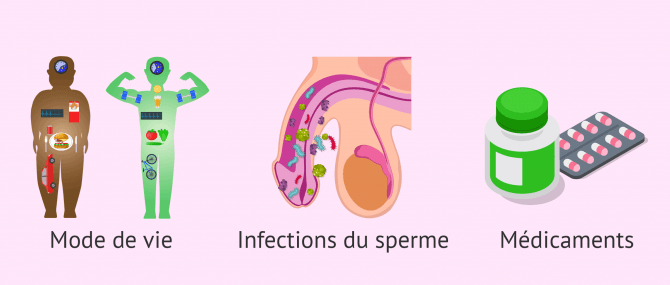
3-Irreversible teratospermia
If a man with teratozoospermia fails to improve his second spermogram after receiving treatment, one may begin to suspect that the teratozoospermia is irreversible.
In these cases, the couple will have to resort to assisted reproduction if they want to become a parent because it will naturally be very difficult to obtain a pregnancy.
In addition, there are other pathologies or situations that cause irreversible or prolonged teratozoospermia. The most relevant cases are examined below:
3-1 Cancer treatment
Chemotherapy and radiation therapy alters both sperm stem cells and sperm production, causing severe teratozoospermia and other more serious changes.
For these reasons, all men with cancer are advised to save a semen sample if they wish to have children in the future after they have overcome the disease.
3-2 Genetic diseases
It is one of the most difficult causes of diagnosis. Normally, when it has not been possible to determine the pathology that causes teratozoospermia, it is attributed to a genetic factor.
Defects in the genes or chromosomes of the sperm are a serious problem because they cannot be corrected.
3-3 Associated pathologies
Teratozoospermia can also result from other diseases that mainly affect the testes, for example:
- Trauma or blows to the testicles, especially in childhood
- Testicular varicocele
- Meningitis
- Diabetic sugar
In addition to all this, the age of males can also affect the morphology of the sperm. In particular, it has been observed that men over 45 have a higher rate of abnormal sperm in their semen.
Irreversible causes of teratozoospermia
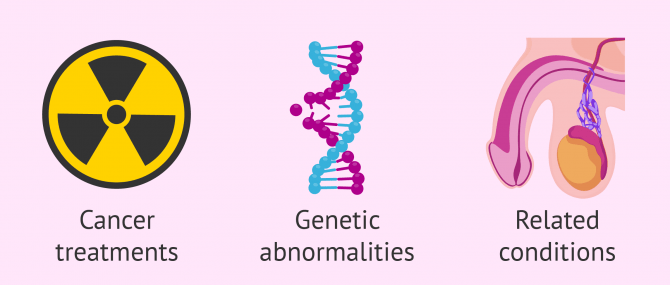
4-Your frequently asked questions
4-1 Can live sperm have poor morphology?
By Zaira Salvador (embryologist).
Yes, teratozoospermia can be present in both living and dead sperm.
Dead sperm do not always have a bad morphology. Sometimes they are confused with immobile sperm and it is necessary to make a tincture to find out whether they are viable or not.
4-2 Can leukospermia cause teratospermia and male infertility?
By Zaira Salvador (embryologist).
Leukospermia, also known as leukocytospermia, is the appearance of leukocytes in semen, with a concentration level greater than 1 million per milliliter. The cause of this seminal pathology is an infection of the male reproductive tract which must be treated with antibiotics as it can affect spermatogenesis and cause oligospermia or teratozoospermia.
You can find the information in our article: Leukocytes in semen.
4-3 Are the causes of teratozoospermia and asthenozoospermia the same?
By Zaira Salvador (embryologist).
In most cases, asthenospermia and teratospermia have the same causes. The two seminal parameters are usually changed in the seminogram, known as astenoteratozoospermia. However, this is not always the case.
We deliver all over the world.
For more information, you can contact our experts on +229 51374202 direct line or by WhatsApp at the same number.
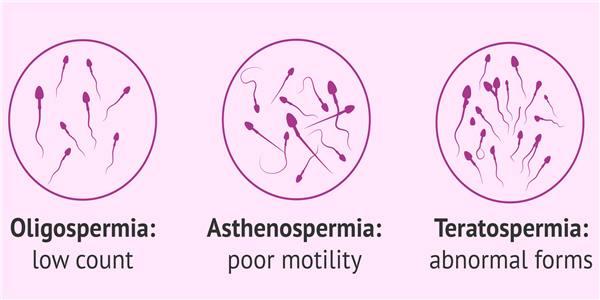
TERATOSPERMIA OR TERATOZOOSPERMIA: definition and treatment
On 26/12/2019
Teratozoospermia or teratospermia is an alteration that occurs in men when more than 95% of their sperm have an abnormal morphology.
Therefore, teratospermia is considered a cause of male infertility due to a sperm factor, and its origin is varied and sometimes unrecognized. This is why the Dawasanté experts provide you with a natural treatment to improve the quality and quantity of your sperm; which will allow you to quickly conceive.
Click HERE or on the image below to discover this natural treatment.
We deliver all over the world.
For more information, you can contact our experts at +229 51374202 direct line or by WhatsApp at the same number
There are several treatments to be able to conceive a child with sperm affected by teratospermia depending on whether the man's sperm has other spermatic disorders, such as, for example, sperm concentration or mobility.
1-Teratozoospermia: what is it?
Poor morphology of the spermatozoa, indeed the latter can present defects in the head, middle part or neck, or the tail.
The WHO estimates that a man with 4% sperm with a normal form (at least) does not have fertility problems. In lower quantity, we are talking about male infertility by teratospermia. This baseline changed in 2010, previously it was 14%, so it is possible that on other sites you will find that teratospermia is considered to be more than 85% abnormal.
According to the strict Kruger criterion, values equal to or greater than 15% of sperm with normal morphology are considered normal. This criterion is always stricter than that of the WHO, but the WHO is the one that is taken as a global reference.
The count of sperm of good or bad morphology is carried out through a medical examination called a spermogram, where the structure of the sperm is analyzed under a microscope.
There are several laboratories which in addition to the Kruger criteria, add those of the WHO.
If the medical report does not specify the details of the analysis to the laboratory, the parameters dictated by the WHO in 2010 are the reference values used.
Diagnosis of teratozoospermia

2-Causes
Teratozoospermia involves male infertility because the sperm that reach the oocyte are unable to fertilize it due to their poor morphology.
The causes that cause the existence of amorphous sperm in human semen are manifold and difficult to diagnose. Here they are:
- Genetic disorders
- Chemotherapy and radiotherapy
- Seminal infections and orchitis
- Varicocele and other testicular disorders
- Febrile period
- Diabetes or meningitis
- Tobacco, alcohol and drug abuse
- Poor lifestyle: poor diet, exposure to toxic substances, clothes that are too tight
Some of these factors can cause reversible teratozoospermia, which goes away with fever, infection, or periods of stress. In the same way, it is possible to recover a good spermatic morphology by improving one's lifestyle, diet, quitting smoking, etc.
3-Types
Sperm morphology defects are classified according to their position on the head, at the neck or at the tail. However, to diagnose teratospermia, all defects are taken into account.
Sperm is considered normal when it has a head with an oval shape and an acrosome inside. The neck or middle piece is slightly larger than the tail, and the tail is elongated and straight.
After analyzing the morphology of the sperm during the spermogram, it is possible to determine the degree of teratozoospermia depending on the seminal quality. For this, the laboratories use the Kruger criteria. Here is their classification:
- Mild teratozoospermia
- 10% to 14% of spermatozoa have normal morphology.
- Moderate teratozoospemia
- the percentage of normal sperm varies between 5% and 9%.
- Severe teratozoospemia
- less than 5% of sperm have normal morphology.
As we have commented before, it is the WHO criteria that are used to diagnose teratospermia, and therefore, this classification is obsolete. However, it is still possible to find it on some spermograms.

3-1 Teratozoospermia index
This seminal parameter is used to know the number of defects that each sperm has. It is possible that sperm has only one malformation, or several distributed over several parts.
In order to calculate the rate of teratospermia (TZI), we use the following formula: TZI = (c + p + q) / x , where each variable means:
- c = head malformations
- p = malformations of the middle part of neck
- q = tail malformations
- x = total number of abnormal sperm
The interpretation of these results is carried out as follows:
- TZI close to 1
- sperm with abnormalities in one area
- TZI close to 2
- spermatozoa with abnormalities in two areas
- TZI nearly 3
- sperm with defects on the head, neck and tail
It is important to note that the same seminal sample can present sperm of three types: one malformation, two, or three. The rate of teratospermia will indicate which type is most present.
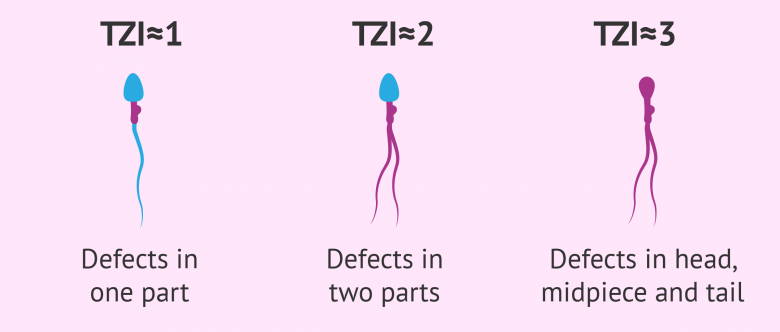
4-Teratospermia and pregnancy
A man with teratospermia could have a natural pregnancy without problems if the rest of the seminal parameters such as concentration or mobility are not affected.
However, in cases where the pregnancy is delayed, it is possible to follow the doctor's recommendations to recover the correct sperm morphology.
On the other hand, if teratospermia has a genetic cause or is congenital, it is more difficult to find an effective treatment to cure it.
4-1 Natural treatments
First of all, men who suffer from teratospermia need to change their lifestyle and put aside bad habits like tobacco or alcohol.
A healthy and balanced diet always helps to recover some of the fertility. In concrete terms, foods rich in antioxidants and essential acids such as L-carnitine help improve sperm quality.
Oily fish is another product rich in omega 3 acids which bring great benefits to human reproductive health.
These nutritional contributions can also be taken by food supplements such as Andean maca or vitamin E supplements, a powerful antioxidant.
4-2 Assisted reproduction (ART)
In the case of fertility treatment to be able to achieve pregnancy and mild teratozoospermia, it is possible to perform artificial insemination (AI), if the concentration and mobility of the sperm allow it.
This is the first option to consider if the woman has no problems with fertility and the only cause of the lack of a pregnancy is teratozoospermia.
Faced with cases of moderate or severe teratospermia, it is necessary to do IVF - ICSI. It is an in vitro fertilization technique that uses the intracytoplasmic injection of sperm for the fertilization of oocytes.
If this topic interests you, you will find information here: IVF.
If you need to undergo IVF treatment to become a mother, we recommend that you use the Fertility Report. In 3 simple steps, which will allow you to know the clinics abroad that meet our rigorous quality criteria. In addition, you will receive a report with useful tips before you make clinic visits.
Finally, there is a new technique which is a variation of the previous one. It is known as IMSI and consists of amplifying the image before the micro-injection to be able to observe the sperm morphology in more detail.
The microscope used by IMSI to select the sperm has an objective that amplifies the image to such an extent that morphological abnormalities are detected.
5-Your frequently asked questions
5-1 What is the cause of teratozoospermia?
Teratozoospermia is an alteration that affects male semen and involves most of the sperm having an abnormal shape.
Due to their poor morphology, sperm cannot fertilize the oocyte and cause sterility.
The causes of teratozoospermia are as follows:
- Genetic alterations
- Chemotherapy and radiotherapy
- Semen infections and orchitis
- Testicular trauma
- Varicocele
- Fever
- Diabetes and meningitis
- Tobacco, alcohol, drugs
Bad eating habits, clothes that are too close to the body ...
Certain causes can be resolved (fever, quitting smoking, healthy habits ...), which implies that in some cases, the pathology is reversible.
5-2 Does teratozoospermia cause miscarriages?
In principle, the poor morphology of the sperm does not cause any miscarriage once the fertilization of the oocyte has taken place and the embryo has implanted. If, on the other hand, the sperm also have genetic disorders, this may be a cause of miscarriage.
5-3 How to improve the amorphous sperm of semen?
If the pathology of teratospermia is not specific, the man should follow some indications to modify his lifestyle, which could negatively influence his reproductive state. Some men who stop smoking or alcohol consumption and change their diet may see an improvement in their sperm quality after 3 months.
5-4 Can leukospermia cause teratospermia and male infertility
Leukospermia, also known as leukocytospermia, is the appearance of leukocytes in semen, with a concentration level greater than 1 million per milliliter. The cause of this seminal pathology is an infection of the male reproductive tract which must be treated with antibiotics as it can affect spermatogenesis and cause oligospermia or teratozoospermia.
You can find the information in our article: Leukocytes in semen.
We deliver all over the world.
For more information, you can contact our experts at +229 51374202 direct line or by WhatsApp at the same number

AZOOSPERMIA CAUSES: natural treatment
On 26/12/2019
What is Azoospermia?
The azoospermia is a sperm abnormality characterized by the total absence of sperm in the ejaculate. It obviously leads to infertility in men, because in the absence of sperm there can be no fertilization. However, Dawasanté experts provide you with a natural herbal treatment to improve the quality and quantity of your sperm. Click here or on the image below to discover this natural treatment.
We deliver all over the world.
For more information, you can contact our experts on +229 51374202 direct line or by WhatsApp at the same number.

Azoospermia affects less than 1% of men in the general population or 5 to 15% of infertile men (1).
The causes
Depending on the cause, there are two types of azoospermia:
Secretory azoospermia (or NOA, for non-obstructive azoospermia)
Spermatogenesis is impaired or absent and the testes do not produce sperm. The cause of this spermatogenesis defect can be:
- hormonal, with hypogonadism (absence or abnormality in the secretion of sex hormones) which may be congenital (Kallmann-Morsier syndrome for example) or acquired, due in particular to pituitary tumors which alter the functioning of the hypothalamic-pituitary axis or after a treatment (eg chemotherapy);
- genetics: Klinefelter syndrome (presence of an extra X chromosome), which affects 1 in 1,200 men (2), structural abnormality of chromosomes, (microdeletion, i.e. loss of a fragment, of the Y chromosome in particular), translocation (one segment of the chromosome detaches and attaches to another). These chromosomal abnormalities are the cause of 5.8% of male infertility problems (3);
- bilateral cryptorchidism: the two testes have not descended into the bursa, which impairs the process of spermatogenesis;
- infection: prostatitis, orchitis.
Obstructive or excretory azoospermia (OA, obstructive azoospermia)
The testes do indeed produce sperm but they cannot be exteriorized due to a blockage of the ducts (epididymis, vas deferens or ejaculatory ducts). The cause may be of origin:
- congenital: the seminal tract has been altered from embryogenesis, resulting in an absence of the vas deferens. In men with cystic fibrosis, a mutation in the CFTR gene can cause the absence of vas deferens;
- infectious: the passages have been blocked following an infection (epididymitis, prostato-vesiculitis, prostatic utricle).
1-Pre-testicular causes
In this case, the origin of azoospermia is due to alterations at the endocrine level, that is, it is manifested by irregularities in the levels of the hormones responsible for regulating sperm production or spermatogenesis. . These are therefore cases of secretory azoospermia.
Among the main endocrine disorders that can cause azoospermia, we can find:
- Hypogonadotropic hypogonadism: this is a deficiency of the hormones released by the pituitary gland and responsible for stimulating the production of sperm in the testes. The main hormones are FSH (follicular stimulation) and LH (luteinizing). This problem can be due to genetic alterations such as Kallmann syndrome, tumors, trauma, pharmacological treatments, consumption of anabolic agents, etc.
- Hyperprolactinemia: it is the excessive increase in the hormone prolactin release. It blocks the hormone GnRH (a hormone that releases gonadotropins), whose function is to regulate the release of FSH and LH. This can be due to the consumption of antihypertensive drugs, stress, tumors, antidepressants, etc.
- Androgen insensitivity syndrome: this is mainly due to genetic mutations that cause resistance to androgens so that full virilization of the patient does not take place. Depending on the degree of severity, testosterone levels can be low, which prevents or hinders spermatogenesis, among other related consequences.
Patients who suffer from azoospermia due to this syndrome will have slightly decreased testicular volume, they will not produce sperm in the testes, and their FSH levels will generally below, except in cases of androgen resistance. In this case, the LH is elevated but the FSH and testosterone concentrations are usually normal or slightly elevated.
Testicular causes
The absence of sperm is due to problems in the testis which hamper spermatogenesis and therefore lead to errors or even blockage of sperm production.
The most common testicular pathologies are:
- Varicocele: dilation of the spermatic veins.
- Cryptorchidism: no descent of the testis from the inguinal canal to the scrotal pocket.
- Orchitis: Inflammation of the testicle, usually due to infection, as is often the case with mumps.
- Genetic alterations
- Testicular torsion
- Trauma
- Continuous increase in testicular temperature
The type of azoospermia from which these patients suffer is also secretory, but the clinical picture is different from the previous one: they have a lower testicular volume (due to non-production of sperm) but the FSH levels are high.
FSH, which is responsible for stimulating the testes to produce sperm, increases. This is why the testes do not respond to their stimulus, the body sends more FSH for the testes to function.
Post-testicular causes
When the cause of azoospermia is post-testicular, it is obstructive azoospermia. In this case, the testes are able to produce sperm properly, but there is a problem in the seminal ducts (vas deferens, epididymis or urethra) responsible for transporting sperm in an ejaculation.
Among these problems, we can highlight:
- Absence of vas deferens: this is a congenital pathology which, if it affects bilaterally, prevents sperm from coming out during ejaculate. This happens, for example, in some cases of cystic fibrosis.
- Obstruction of the vas deferens, the epididymis, or the urethra: it may be involuntary (trauma, surgery or disease) or voluntary. This is called a vasectomy.
Patients have a normal testicular size and FSH hormone levels are also average. Obstructive azoospermia is the least serious compared to fertility. It allows the man to obtain a pregnancy, either naturally, by a medical intervention which makes it possible to unblock the channels, or by obtaining sperm directly from the testicle and the subsequent application of a medically assisted procreation technique.
Your frequently asked questions
Is varicocele a cause of infertility in men?
By Victoria Moliner (embryologist).
Yes, varicocele can be a cause of male infertility. This pathology can manifest itself in different degrees of affection, so its harmful effect on male fertility (which mainly causes seminal and hormonal changes) can also be from mild to severe.
Is hormonal azoospermia always secretory?
By Andrea Rodrigo (embryologist).
Yes, when the lack of sperm is caused by hormonal problems, it is secretory azoospermia because of the lack of regulation by hormones prevents or complicates spermatogenesis.
Can cycling be the cause of my testicular factor azoospermia?
By Andrea Rodrigo (embryologist).
Continued use of the bicycle does not necessarily cause azoospermia, provided that the correct position is taken on the bicycle and, in some cases, certain testicular protection systems are used.
Routine improper use of the bicycle can increase the temperature of the scrotal region and thus prevent the proper production of sperm, which can reduce the quality of sperm.
As an added note, it is important to note that excessive exercise can affect sperm production in addition to other bodily functions.
Is azoospermia reversible?
By Andrea Rodrigo (embryologist).
It is possible that azoospermia is transient or punctual and, therefore, we can speak of reversible azoospermia. This means that, although it is unusual, a man may have a certain period of azoospermia, for example, due to stress or some other situation, and after this period recover the production of sperm and, with it, the presence of these in the ejaculate.
Read more
Why is there an absence of sperm in the spermogram?
By Zaira Salvador (embryologist).
When a man gets zero sperm as a result of his semen analysis, he may have azoospermia. First of all, this diagnosis should always be confirmed by a second spermogram, in case an error may have occurred while handling the first sample.
If azoospermia is confirmed, there are several causes of this seminal alteration, from blockage of the seminal ducts to problems with sperm production. More human testing should be done to find a more complete diagnosis.
We deliver all over the world.
For more information, you can contact our experts on +229 51374202 direct line or by WhatsApp at the same number.

